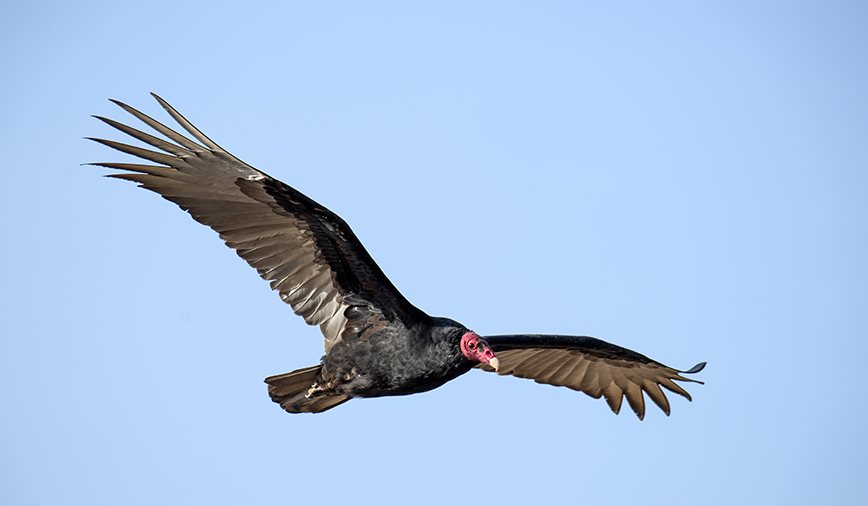Driving along Peck Road the other day, a merry band of naturalists spotted a TV dinner on the pavement. Even better, the TV was right next to it!
Now, before visions of Swanson’s Salisbury Steak and a Sony flatscreen start dancing in your head, hold on. The dinner we discovered was a dead raccoon, and the TV was, of course, a Turkey Vulture.
Turkey vultures occupy the ecological niche of scavenger; they are the cleanup crew in the circus of life. “If it’s dead, it’s dinner,” is their motto, and our natural world is a tidier place because of them. (Fun fact: The vulture’s scientific name is Cathartes aura, Latinized from the Greek word kathaet?s, or purifier, and auroura, a Native Mexican word for turkey vulture.)
The TV on Peck Road was acting just as you’d expect such a bird to act—if you do indeed hold such expectations. It was tugging the unfortunate mammal farther onto the shoulder of the road, all the better to feed without becoming roadkill itself. Later, as we drove back in the opposite direction, the bird was tearing away at the carcass, seemingly relishing each meaty bite. (More fun! The name “vulture” comes from the Latin word vulturus, meaning “tearer.”)
While the turkey vulture’s large, curved beak works well on smaller animals, it lacks the strength to tackle thicker hides like deer. In such cases, TVs will wait for other animals, such as coyotes, to “pop the cork,” so to speak, before feasting on what remains.
What turkey vultures do excel at is finding fresh carrion. Through a combination of scent—TVs are one of a small number of birds that possess a sense of smell—and sight, these birds will hone in on recently dispatched animals and descend to eat their fill.
While feeding, another TV adaptation comes into play. Carcasses, no matter how fresh, can turn messy quickly; hence, turkey vultures are conveniently equipped with virtually bare skin instead of feathers on their heads. A couple quick shakes, maybe a short bake in the sun and voila! The goo is gone. (Imagine spilling a caramel sundae on shag carpeting. Now picture the same stuff, only on vinyl flooring. Which would you rather clean up?)
But even the best-equipped scavengers need a little diversity in life. Some research indicates that TVs do, from time to time, take advantage of plants as food sources.
I can’t say for sure, but I may have witnessed just such an oddity about this time last year, on the northeast corner of 14th Street and Route 38 in St. Charles. On my way to a party, I was waylaid by the sight of seven turkey vultures near the farm field there. As three of the big birds kept watch from a dead tree branch, the other four pulled at what looked like grass on the ground; grass stems were certainly flying as the birds yanked and swallowed.
But was it really grass they were eating? I couldn’t see from where I stood (yeah, by this point I’d pulled over into the empty bank parking lot just west of 14th and had the binoculars out). Maybe there were insects of some sort on the ground, or perhaps the birds were grazing on carrion bits sprayed from a lawnmower chute. I may never know. But one thing’s for sure. The incident offered plenty of food for thought at the party—a gathering of naturalists—that night.
Want to see turkey vultures for yourself? Pick a warm sunny day anytime from now until October, the month TVs head south for winter. Head for a nearby natural area, and look up. Sooner more often than later, a dark form will pass high overhead, tilting just slightly side to side as it soars on warm air currents called thermals.
The wingspan will be large—nearly six feet—but more important, the wings will be held in a characteristic V shape known as a dihedral. (The other large, dark soaring bird in our area, the bald eagle, holds its wings nearly straight.)
If you’re really lucky, the form will descend and land by something dead—a rabbit or opossum, perhaps. Tune in to the action at hand, and enjoy your very own TV show!
Pam Otto is the manager of nature programs and interpretive services for the St. Charles Park District and can be reached at potto@stcparks.org or 630-513-4346.

